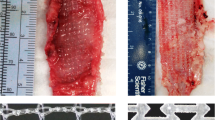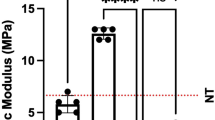Abstract
Introduction and hypothesis
The aims of this study were to evaluate the effectiveness of gelatin methacryloyl as an adjunct to anterior vaginal wall injury with or without vaginal mesh compared with traditional repair with suture.
Methods
Virginal cycling Hartley strain guinea pigs (n = 60) were randomized to undergo surgical injury and repair using either polyglactin 910 suture or gelatin methacryloyl for epithelium re-approximation or anterior colporrhaphy with mesh augmentation using either polyglactin 910 suture or gelatin methacryloyl for mesh fixation and epithelium re-approximation. Noninjured controls (n = 5) were also evaluated. After 4 days, 4 weeks, or 3 months, tissues were analyzed by hematoxylin & eosin in addition to immunolabeling for macrophages, leukocytes, smooth muscle, and fibroblasts.
Results
Surgical injury repaired with suture was associated with increased inflammation and vessel density compared with gelatin methacryloyl. Vimentin and α-smooth muscle actin expression were increased with gelatin methacryloyl at 4 days (p = 0.0026, p = 0.0272). There were no differences in changes in smooth muscle or overall histomorphology after 3 months between the two closure techniques. Mesh repair with suture was also associated with increased inflammation and vessel density relative to gelatin methacryloyl. Quantification of collagen content by picrosirius red staining revealed increased thick collagen fibers throughout the implanted mesh with gelatin methacryloyl compared with suture at 4 weeks (0.62 ± 0.01 μm2 vs 0.55 ± 0.01, p = 0.018). Even at the long-term time point of 3 months, mesh repair with suture resulted in a profibrotic encapsulation of the mesh fibers, which was minimal with gelatin methacryloyl. Smooth muscle density was suppressed after mesh implantation returning to baseline levels at 3 months regardless of fixation with suture or gelatin methacryloyl.
Conclusions
These results suggest that gelatin methacryloyl might be a safe alternative to suture for epithelium re-approximation and anchoring of prolapse meshes to the vagina and may improve chronic inflammation in the vaginal wall associated with mesh complications.






Similar content being viewed by others
References
Olsen AL, Smith VJ, Bergstrom JO, Colling JC, Clark AL. Epidemiology of surgically managed pelvic organ prolapse and urinary incontinence. Obstet Gynecol. 1997;89:501–6.
Wu JM, Hundley AF, Fulton RG, Myers ER. Forecasting the prevalence of pelvic floor disorders in U.S. Women: 2010 to 2050. Obstet Gynecol. 2009;114:1278–83.
Urogynecologic Surgical Mesh Implants 2019. 2019, at https://www.fda.gov/medical-devices/implants-and-prosthetics/urogynecologic-surgical-mesh-implants.
Nygaard I, Brubaker L, Zyczynski HM, et al. Long-term outcomes following abdominal sacrocolpopexy for pelvic organ prolapse. JAMA. 2013;309:2016–24.
Barone WR, Amini R, Maiti S, Moalli PA, Abramowitch SD. The impact of boundary conditions on surface curvature of polypropylene mesh in response to uniaxial loading. J Biomech. 2015;48:1566–74.
Liang R, Knight K, Abramowitch S, Moalli PA. Exploring the basic science of prolapse meshes. Curr Opin Obstet Gynecol. 2016;28:413–9.
Yue K, Trujillo-de Santiago G, Alvarez MM, Tamayol A, Annabi N, Khademhosseini A. Synthesis, properties, and biomedical applications of gelatin methacryloyl (GelMA) hydrogels. Biomaterials. 2015;73:254–71.
Noshadi I, Hong S, Sullivan KE, et al. In vitro and in vivo analysis of visible light crosslinkable gelatin methacryloyl (GelMA) hydrogels. Biomater Sci. 2017;5:2093–105.
Assmann A, Vegh A, Ghasemi-Rad M, et al. A highly adhesive and naturally derived sealant. Biomaterials. 2017;140:115–27.
Charan J, Kantharia ND. How to calculate sample size in animal studies? J Pharmacol Pharmacother. 2013;4:303–6.
Brown BN, Mani D, Nolfi AL, Liang R, Abramowitch SD, Moalli PA. Characterization of the host inflammatory response following implantation of prolapse mesh in rhesus macaque. Am J Obstet Gynecol. 2015;213(668):e1–10.
Nolfi AL, Brown BN, Liang R, et al. Host response to synthetic mesh in women with mesh complications. Am J Obstet Gynecol. 2016;215(206):e1–8.
Sung KY, Lee SY. A chronic, nonhealing wound of the finger caused by polypropylene suture material. Wounds. 2015;27:E16–9.
Horton CE, Adamson JE, Mladick RA, Carraway JH. Vicryl synthetic absorbable sutures. Am Surg. 1974;40:729–31.
Van Rijssel EJ, Trimbos JB, da Costa A, Fleuren GJ, Brand R. Assessment of tissue reaction at suture knots; an adaptation of Sewell's scoring system. Eur J Obstet Gynecol Reprod Biol. 1988;27:165–72.
Li L, Wang X, Park JY, Chen H, Wang Y, Zheng W. Pathological findings in explanted vaginal mesh. Hum Pathol. 2017;69:46–54.
Shaffer RM, Liang R, Knight K, Carter-Brooks CM, Abramowitch S, Moalli PA. Impact of polypropylene prolapse mesh on vaginal smooth muscle in rhesus macaque. Am J Obstet Gynecol. 2019;221(330):e1–9.
Gualtieri M, Zhang Y, Candiotti K, Yavagal S, Medina CA, Takacs P. The effect of biological and synthetic meshes on vaginal smooth muscle cell proliferation. Neurourol Urodyn. 2011;30:435–7.
Takacs P, Zhang Y, Jaramillo S, Bardawil T, Candiotti K, Medina CA. The effects of estrogen, progesterone and polypropylene mesh on vaginal smooth muscle cell proliferation. J Smooth Muscle Res. 2010;46:9–15.
D'Alessandro S, Magnavacca A, Perego F, et al. Effect of hypoxia on gene expression in cell populations involved in wound healing. Biomed Res Int. 2019;2019:2626374.
Steinbrech DS, Longaker MT, Mehrara BJ, et al. Fibroblast response to hypoxia: the relationship between angiogenesis and matrix regulation. J Surg Res. 1999;84:127–33.
Zaruby J, Gingras K, Taylor J, Maul D. An in vivo comparison of barbed suture devices and conventional monofilament sutures for cosmetic skin closure: biomechanical wound strength and histology. Aesthet Surg J. 2011;31:232–40.
DiPietro LA. Angiogenesis and wound repair: when enough is enough. J Leukoc Biol. 2016;100:979–84.
Balgobin S, Montoya TI, Shi H, et al. Estrogen alters remodeling of the vaginal wall after surgical injury in guinea pigs. Biol Reprod. 2013;89:138.
Financial support
This work was supported by NIH AG028048, Dedman’s Scholar grant from the University of Texas Southwestern Medical Center.
Author information
Authors and Affiliations
Contributions
L. Jackson: data collection or management, data analysis, manuscript writing/editing; H. Shi: data collection or management, data analysis, manuscript writing/editing; J. Acevedo: data collection or management, data analysis, manuscript writing/editing; S. Lee: data analysis, manuscript writing/editing; N. Annabi: protocol/project development, data analysis, manuscript writing/editing; A. Word: protocol/project development, data analysis, manuscript writing/editing; M. Florian-Rodriguez: protocol/project development, data collection or management, data analysis, manuscript writing/editing.
Corresponding author
Ethics declarations
Conflicts of interest
The authors report no conflicts of interest.
Additional information
Publisher’s note
Springer Nature remains neutral with regard to jurisdictional claims in published maps and institutional affiliations.
Supplementary Information
Supplementary Table 1
(DOCX 14 kb)
Supplementary Figure 1
Effect of suture or GelMA on smooth muscle and fibroblasts in the vaginal wall after anterior colporrhaphy with mesh. Sections from tissues repaired with suture at a 4 weeks or b 3 months or c GelMA at 4 week or d 3 months were double labeled with anti-SMA (red) and anti-vimentin (green) antibodies as described in Materials and methods. Quantification of smooth muscle area is presented in panels e (muscularis) and f (lamina propria). *p < 0.05 compared with noninjured controls. Epi epithelium, M muscularis, LP lamina propria, EUS external urethral sphincter, Ca profibrotic capsule
Supplementary Figure 2
Effect of suture or GelMA on vimentin expression in the vaginal wall after anterior colporrhaphy with mesh. Quantification of vimentin positive area in a anterior vaginal wall muscularis or b lamina propria. *p < 0.05 compared with noninjured controls
Supplementary Figure 3
Impact of suture or GelMA on total collagen content in the vaginal wall after anterior colporrhaphy with mesh. Sections stained with picrosirius red from tissues of a noninjured controls or after anterior colporrhaphy repaired with mesh and b suture or c GelMA at 4 weeks post-procedure. Note that collagen fibers surrounding suture are not aligned (b) relative to the more aligned fibers surrounding GelMA (c). Black circles mesh pores, EUS external urethral sphincter, Epi vaginal epithelium, M muscularis, LP lamina propria
Rights and permissions
About this article
Cite this article
Jackson, L.A., Shi, H., Acevedo, J. et al. Effect of gelatin methacryloyl hydrogel on healing of the guinea pig vaginal wall with or without mesh augmentation. Int Urogynecol J 33, 2223–2232 (2022). https://doi.org/10.1007/s00192-021-05031-2
Received:
Accepted:
Published:
Issue Date:
DOI: https://doi.org/10.1007/s00192-021-05031-2




